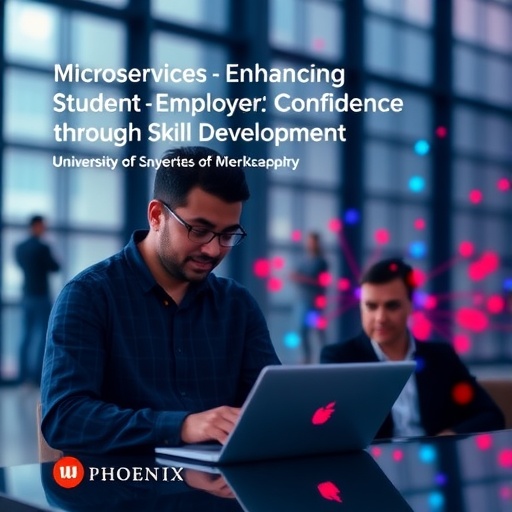The University of Phoenix has made significant strides in bridging the gap between students and employers with its new white paper titled “Leveraging Achieved Skills to Improve Confidence Between Students and Employers.” This important publication, crafted by Francisco Contreras and Brandon Edwards from the University’s careers product team, presents a comprehensive analysis of how a detailed record of students’ achievements alongside verified skills can foster a more cohesive dialogue between job seekers and hiring managers. By adopting a shared language based on skills, the initiative aims to elevate the confidence of both students looking to enter the workforce and employers seeking qualified candidates.
Central to the premise of this white paper is the idea that when learners receive clear visibility into their skill sets, derived from both academic coursework and experiential learning, they are more likely to see themselves as viable candidates for job opportunities. This transparency not only benefits students but also creates a more streamlined experience for employers, allowing them to quickly identify suitable candidates. Francisco Contreras, senior product manager, emphasizes this point, indicating that increased visibility of granular skills leads directly to a heightened sense of confidence in the application process. When both sides recognize the achievability of a match, it increases the likelihood that prospective applicants will take the initiative to apply for available positions.
In conducting their research, the authors have outlined how the University of Phoenix has strategically aligned its academic programs with in-demand market skills. By integrating a standardized skills taxonomy, the design team created a microservice that meticulously tracks student achievements and skills. This technology not only functions to catalog accomplishments but also plays a crucial role in presenting tailored job postings to students. When job opportunities correspond with a learner’s verified skills or skills they are in the process of acquiring, both the students and potential employers benefit from this alignment.
The findings showcased in the white paper include results from initial talent recruitment experiments that provide promising insights into this model’s effectiveness. For instance, one experiment involved a pilot job posting that reached 22 students. Remarkably, over 31% of those students clicked to apply, and among those who expressed interest, 71% went on to submit a résumé. The quality of candidates also varied favorably, with 80% of résumé submitters being rated as “good candidates” by recruiters. These statistics underscore the direct correlation between well-mapped skills and the success factors inherent in recruitment.
A subsequent iteration of similar job postings yielded even more promising results, with a posting viewed by 27 students resulting in over 55% clicking to apply and a significant 40% submitting their résumés. These figures demonstrate that an efficient matching process not only amplifies application rates but simultaneously empowers students to pursue roles they might have otherwise deemed unattainable.
Brandon Edwards, an engineer within the product team, notes the importance of structured skill data in enhancing recruiter efficiency. The ability to perform rapid queries means that talent teams can fine-tune their search criteria in real time, aligning job requirements with skills present within a candidate pool. This agile responsiveness reduces hiring timeframes and enhances the overall recruitment experience. The team has methodically constructed tools that allow recruiters to identify candidates whose skills align closely with current job opportunities.
The insights presented in this white paper highlight fundamental changes in how organizations approach recruitment. With skills now being treated as a shared language, transparency surrounding a candidate’s qualifications can significantly reduce the hesitancy that often plagues the job application process. For hiring managers, a well-documented skill set reduces uncertainty, fostering an environment of trust and reliability.
This innovative approach also provides a broader view of candidates through the combination of course-mapped skills and self-attested competencies. Rather than relying solely on traditional transcripts, recruiters have access to a comprehensive, three-dimensional view of potential hires. This multifaceted assessment allows talent teams to engage with a richer dataset, ultimately leading to more informed hiring decisions.
The Career Accelerator Team at the University of Phoenix has played a pivotal role in this initiative. By adopting a user-centric product development methodology, the team consistently collaborates with both students and recruiters. Continuous feedback gathered from interviews and user experience studies ensures that the system evolves to meet the needs of its users seamlessly. The emphasis on a design-thinking approach within an Agile framework encourages rapid iterations and improvements, all centered on fostering connections between skilled learners and potential employers.
Ultimately, the foundational microservice supporting this innovative recruitment strategy will underpin the development of the Talent Sourcing Tool. As work on this tool progresses, it will create a robust platform designed to effectively connect employers with students and alumni of the University of Phoenix through the Career Navigator system. By providing clearly defined paths for job seekers to access suitable opportunities, the tool aims to remove barriers and enable a more direct route to employment success.
This white paper, now accessible through the University of Phoenix Media Center, represents a significant contribution to the ongoing discourse on skills transparency and its impact on job placement. By uniting employers and students through a shared language of skills and achievements, this initiative promises to reshape the landscape of recruitment. Readers interested in the full scope of the research findings and implications are encouraged to delve deeper into the report, which is available online.
Those wishing to explore the implications of this groundbreaking work may find further insights and analytical discussions within the University’s resources. As the landscape of job recruitment continues to evolve, the University of Phoenix stands at the forefront, leveraging data-driven methodologies to enhance the social fabric of education and employment.
Subject of Research: The Role of Skills Transparency in Recruitment
Article Title: Leveraging Achieved Skills to Improve Confidence Between Students and Employers
News Publication Date: October 2023
Web References: University of Phoenix Media Center
References: None
Image Credits: University of Phoenix
Keywords
Education Technology, Online Education, Skill Transparency, Recruitment Strategies, Career Development




